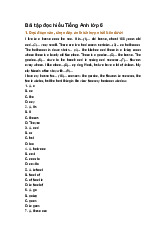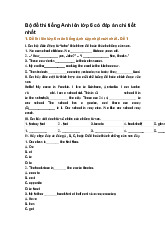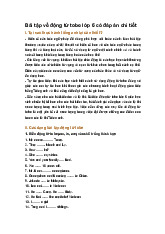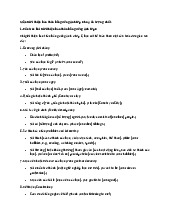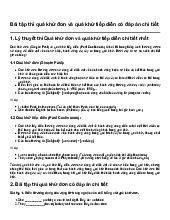














Preview text:
MA TRẬN ĐỀ KIỂM TRA CUỐI KỲ 1
THỜI GIAN LÀM BÀI: 90 PHÚT Mứcđộnhậnthức Tổng Nhậnbiết Thônghiểu Vậndụng Vậndụngcao TT Kĩnăng Tỉlệ Thờigian Tỉlệ (%) Thờigian Thờigian Thờigian Thờigian Tỉlệ (%) Tỉlệ (%) Tỉlệ (%) (%) (phút) (phút) (phút) (phút) (phút) 1 Nghe 8= 4 4 8= 4 câu 8 4= 2 câu 4 20 16 câu 2 Ngônngữ 10= 5 8 10= 5 câu 8 20 15 câu 3 Đọc 8= 4 4 6= 3 câu 6 6= 3 câu 9 20 19 câu 4 Viết 4= 2 câu 6 6= 3 câu 10 10 12 20 28 5 Nói 4 3 12 4 4 5 20 12 Tổng 26 16 32 31 28 27 14 17 100 90 Tỉlệ (% ) 26 32 28 14 100 Tỉlệchung (%) 58 42 100 Lưu ý:
- Thờigianmangtínhđềxuất, cánbộrađềthamkhảođểlựachọnsốcâuhỏichophùhợpvớithờigianấnđịnhcủabàikiểmtra.
- Tỉlệmứcđộnhậnthứcmangtínhđềxuất.
- Tỉlệgiữacáckỹnăngvàkiếnthứcngônngữcóthểđiềuchỉnhtrongkhoảng 5%.
- Tỉlệđượctínhdựatrênđiểmsố, khôngtínhtrênsốlượngcâuhỏi.
- Tỉlệgiữacâutrắcnghiệmkháchquanvàcâutựluậnlàtươngđối, cóthểđiềuchỉnhtheođiềukiệnthựctế. Page 1 of 15
BẢNG ĐẶC TẢ KĨ THUẬT ĐỀ KIỂM TRA CUỐI KỲ 1
MÔN: TIẾNG ANH 6 – THỜI GIAN LÀM BÀI: 60 – 90 PHÚT
Số câu hỏi theo mức độ nhận thức
Đơn vị kiến thức/kỹ
Mức độ kiến thức, kĩ năng Thông Tổng Số CH TT Nhận Vận Vận Kĩ năng năng
cần kiểm tra, đánh giá biết hiểu dụng dụng cao
TN TL TN TL TN TL
TN TL TN TL I.
LISTENING 1. Nghe một đoạn hội Nhận biết:
thoại/ độc thoại trong 2 -3 2 2 phút (khoảng 80 –
- Nghe lấy thông tin chi tiết. 100 từ)
để trả lời các dạng câu hỏi Thông hiểu:
có liên quan đến các chủ
- Hiểu nội dung chính của đoạn độc 2 2
đề đã học trong học kỳ 1: thoại/ hội thoại để tìm câu trả lời đúng.
Listen and write. Vận dụng:
- Nắm được ý chính của bài nghe để
đưa ra câu trả lời phù hợp.
- Tổng hợp thông tin từ nhiều chi
tiết, loại trừ các chi tiết sai để tìm câu trả lời đúng. 2. Nghe một đoạn hội Nhận biết:
thoại/ độc thoại khoảng 2 1 1 -
- Nghe lấy thông tin chi tiết. 3 phút (khoảng 80 – 100 Thông hiểu:
từ) liên quan đến các chủ - Hiểu nội dung chính của đoạn độc
đề đã học trong học kỳ 1. thoại/ hội thoại để tìm câu trả lời 2 2
- Listen and tick đúng. Vận dụng:
- Nắm được ý chính của bài nghe để
đưa ra câu trả lời phù hợp. 3 3
- Tổng hợp thông tin từ nhiều chi
tiết, loại trừ các chi tiết sai để tìm câu trả lời đúng. II.
LANGUAGE 1. Vocabulary Nhận biết:
Từ vựng đã học theo chủ - Nhận ra, nhớ lại, liệt kê được các 2 2 điểm.
từ vựng theo chủ đề đã học. Page 2 of 15 Thông hiểu:
- Hiểu và phân biệt được các từ
vựng theo chủ đề đã học. 1 1
- Nắm được các mối liên kết và kết
hợp của từ trong bối cảnh và ngữ cảnh tương ứng. Vận dụng:
- Hiểu và vận dụng được từ vựng đã
học trong văn cảnh (danh từ, động
từ, tính từ và trạng từ…) Nhận biết:
- Nhận ra được các kiến thức ngữ 3 3 pháp đã học. 2. Grammar
Các chủ điểm ngữ pháp Thông hiểu: đã học.
- Hiểu và phân biệt các chủ điểm 2 2 ngữ pháp đã học. Vận dụng:
- Hiểu và vận dụng các kiến thức
ngữ pháp đã học vào bài nghe/ nói/ đọc/ viết. Thông hiểu:
3. Error identification Xác định lỗi sai
- Nhận diện lỗi về ngữ pháp và từ 2 2
loại trong câu và sửa chúng. III. READING 1. Cloze test Nhận biết:
Hiểu được bài đọc có độ
- Nhận ra được các thành tố ngôn 2 2
dài khoảng 80-100 từ về
ngữ và liên kết về mặt văn bản.
các chủ điểm đã học. Thông hiểu:
(Từ vựng, lượng từ, liên
- Phân biệt được các đặc trưng, đặc từ, giới từ… 2 2 )
điểm các thành tố ngôn ngữ và liên kết về mặt văn bản. Vận dụng:
- Sử dụng các kiến thức ngôn ngữ
và kỹ năng trong các tình huống 1 1 mới. 2. Reading Nhận biết: 2 2 comprehension - Thông tin chi tiết
Hiểu được nội dung chính Thông hiểu:
và nội dung chi tiết đoạn
- Hiểu ý chính của bài đọc và chọn 1 1 Page 3 of 15
văn bản có độ dài khoảng câu trả lời phù hợp. 100-120 từ, xoay quanh
- Hiểu được nghĩa tham chiếu. các chủ điểm có trong
- Loại trừ các chi tiết để đưa ra câu chương trình trả lời phù hợp
( Tiêu đề, từ quy chiếu, tù
đồng nghĩa/ trái nghĩa, Vận dụng:
thông tin chi tiết có trong - Đoán nghĩa của từ trong văn cảnh. bài) 2 2
- Hiều, phân tích, tổng hợp ý chính
của bài để chọn câu trả lời phù hợp. IV. WRITING Thông hiểu: 1. Sentence
- Sử dụng các từ đã để sắp xếp 2 2 thành câu hoàn chỉnh. transformation
Viết lại câu dùng từ gợi ý Vận dụng: hoặc từ cho trước
- Hiểu câu gốc và sử dụng các từ
gợi ý để viết lại câu sao cho nghĩa 3 3 không thay đổi. 2. Write an email / a Vận dụng cao: paragraph
– Viết (có hướng dẫn) một đoạn văn
Viết thư điện tử/ Viết
ngắn khoảng 100 –120 về một chủ đoạn văn
đề đã học, hoặc một vấn đề liên
quan đến các chủ đề đã học trong 1 bài
chương trình hoặc viết thư cá nhân
liên quan các vấn đề thuộc lĩnh vực quan tâm. V.
SPEAKING (Phần SPEAKING tổ
chức thi buổi riêng) + Nội dung:
- Hỏi - đáp và trình bày về
các nội dung liên quan
đến các chủ điểm có trong chương trình.
- Sử dụng được một số
chức năng giao tiếp cơ
bản như hướng dẫn, bày
tỏ ý kiến, hỏi đường, hỏi
thông tin và cung cấp Page 4 of 15 thông tin, … + Kỹ năng:
- Kỹ năng trình bày một
vấn đề; sử dụng ngôn ngữ
cơ thể và các biểu đạt trên
khuôn mặt phù hợp; kỹ
năng nói trước đám đông…
+ Ngôn ngữ và cấu trúc:
- Ưu tiên sử dụng những
cấu trúc đã học trong chương trình.
(Các chủ đề nói trong
phần ghi chú) Thông hiểu:
- Giới thiệu các thông tin về bản 1. Introduction
thân/ sở thích/ về thầy cô, mái 5%
trường/ môn học yêu thích. Vận dụng:
- Sử dụng từ vựng và cấu trúc linh 1 bài* 2. Topic speaking 1ba
hoạt, diễn tả được nội dung cần nói
theo những cách khác nhau. Phát i 10%
âm tương đối chuẩn. Vận dụng cao:
- Hiểu và trả lời được câu hỏi của 1 bài* 3. Q&A 1bà
giám khảo và trả lời một cách linh
hoạt. Sử dụng ngôn ngữ một cách i 5 %
tự nhiên và thuần thục. 15 Tổng 2bà 11 2 8 4 6 4 + i 22 1 bài Page 5 of 15
ĐỀ KIỂM TRA ĐÁNH GIÁ CUỐI KỲ 1
NĂM HỌC …………..
MÔN TIẾNG ANH – LỚP 6
(Làm bài trong 90 phút – Thí sinh làm bài trực tiếp vào đề)
Nhận biếtThông hiểuVận dụngVận dụng cao
PART A: LISTENING (2.0 pts)
Hướng dẫn phần thi nghe hiểu: -
Nội dung nghe gồm 2 phần, mỗi phần thí sinh được nghe 2 lần, đĩa CD tự chạy 2 lần.
Hướng dẫn làm bài chi tiết cho thí sinh (bằng tiếng Anh) đã có trong bài nghe. -
I. Listen to Tracy talking about her house and tick (✓) T (True) or F (False). (1p) Statements T F 1. Tracy has two brothers.
2.Tracy’s house is opposite a department store.
3. The kitchen is small with nice bowls and chopsticks.
4. The cupboard is near some flowers.
5. She doesn’t love her house. 1. T 2. T 3. F 4. T 5.
II. Listen to Tracy talking about her house. Circle the best choice (A, B or C). You will listen TWICE.
1.How many people are there in Tracy’s family? A. Three. B. Four. C. Five.
2. When does Tracy’s family go to the department store? Page 6 of 15
A. On Saturdays and Sundays. B. OnMondays. C. OnThursdays.
3. How many rooms does her house have?
A. It has seven rooms. B. It has five rooms. C.It has eight rooms. 4.What is in Tracy’s room? A. A TV. B. Many books. C. A wardrobe.
5. Why does she love her house?
A. Because it is dirty. B. Because it is nice and tidy.
C. Because it is large and untidy. Tapescripts:
Tracy: Hi, I’m Tracy. There are five people in my family: my dad, my mom, my two
brothers and me. Our house is opposite a department store. We often go there at
weekends to buy things for homes. Now, about the house. It has three bedrooms,
two bathrooms, a living room and a kitchen. There isn’t a TV in my bedroom,
but there are a lot of books. The kitchen is big and it has beautiful bowls and
chopsticks. My mom often puts some flowers near the cupboard. I love my house
because it is nice and tidy.
PART B: VOCABULARY AND GRAMMAR (2.0 pts)
I. Choose the correct answers. (1.6 pts)
1. Diana is in the art club. She likes painting pictures, and everyone enjoys them. She is very ___________ . A. shy B. kind C. funny D. creative
2. Do you and Vui play volleyball ? Yes, .................. A. we do B. they do C.you do D. I do
There are many chairs in the kitchen, __________ there is only one in my bedroom. A. so B. because C. but D. in
3. My father works _________ a factory. A. in B. with C. on D. by
4.My new house is ________ than the old house. Page 7 of 15 A. more convenient B. convenient C. the convenient D. most convenient
5. My mother is a good cook. She often ________ special food at Tet. A. buys B. cooks C. takes D. brings
6. Tet is a time for family _________. A. working B. cooking C. playing D. gathering
7. I’d like ______________oranges. A.an B. any C. some D. a
8. You ________ speak during the exam. It’s forbidden. A. should B. shouldn’t C. must D. mustn’t
II. Find and correct the mistakes in these sentences.(0.4 pts)
9.She is wanting to buy a new computer. A B C D
=>A (is wanting => wants)
10.There are six room in my house. A B C C =>C-> rooms
I. Read the following passage and mark letter A, B, C or D to indicate the correct word that best completes each blank.
Ba’s bedroom is big but (1) ................. . There (2)...............clothes on the floor. There is a big desk near the window, and there are dirty bowls
and chopsticks on it. He often puts his schoolbag under the desk . His bed is (3) .............. to the desk, and it is also untidy. There is a cap, some CDs
and .........................(4)books on the bed. Ba’s mum is(5) ................. with this, and now Ba is tidying up his room.
1. A. small B. tidy C.messy D.clean 2. A.are B. be C. were D. Am
3. A. near B.behind C.between D. Next 4. A. a B. some C.little D. Much 5. A. happy B .unhappily C.unhappy D. happier
II.Read the following passage then answer questions below Page 8 of 15
This is Nga’s grandma. She used to live on a farm when she was a young girl. Life was hard then so she didn’t go to school because she had to
stay home and help her mom. She used to look after her younger brothers and sisters.
Nga’s great- grandma used to cook the meals, clean the house and wash the clothes. That was a hard work and there wasn’t any electricity then
so she had to do everything without the help of modern equipment.
In the evening, Nga’s great- grandmother and great-grandfather used to stay home. She lit the lamp and he used to tell Nga’s grandma stories
after dinner. And the best one Nga’s grandma still remembered was The Lost Shoe.
1. Where did Nga’s grandma use to live when she was a young girl? ~ _____________. A. On a farm B. In a city C. In a school D. In a town
2.Was the life difficult then? ~ ________________. A. No, it was B. Yes, it was C. No, life wasn’t D. Yes, life was
3.What did Nga’s grandma have to do when she was young? ~____________________. A. She used to live on a farm
B. She had to stay home and give her mom a hand.
C. She had to take care of her younger brothers and sisters D. Both B and C are correct
4. Nga’s great- grandma used to do everything without the help of modern equipment because there was no _____________ then. A. traditional stories B. folktales C. electricity D. clothes
5.What does the word “one” in line 8 mean? A. A story B. A lamp C. A shoe D. electricity
PART D: WRITING (2.0 pts)
I.Rearrange the words / phrases to make correct sentences. (0,4 pts)
1. There / many things / my / I / about / neighbourhood / like / are / .
____________________________________________________________
=>- There are many things I like about my neighbourhood.
2. should/not/You/stay up late /.
____________________________________________________________ Page 9 of 15
=>You should not stay up late. .
II. Rewrite the sentences using the words in brackets. Do not change the meaning of the sentences and do not change the form of the words. (0,6pts)
1. A city is noisier than a village. (PEACEFUL)
=> ____________________________________________________________
=>A village is more peaceful than a city.
2. We have a sink, a fridge, a cooker and a cupboard in our kitchen.(THERE)
____________________________________________________________
=>There is a sink, a fridge, a cooker and a cupboard in our kitchen
3. How many times a week do you go to your painting club?(HOW OFTEN)
____________________________________________________________
=>How often do you go to your painting club?
III. Write a paragraph about your neighbourhood (about 60 words), using the cues below:(1,0pts)?
– Where is your neighbourhood? (in the city, near a city, in the country, in the mountains, etc.)
– What can you see in your neighbourhood? (streets, houses, trees, hills, shopping centres, schools, cinemas, etc.)
– What are the streets / the houses / the shops, etc. in your neighbourhood like?
– Do you like living in your neighbourhood? Why / Why not? Writing criterias:
- good organization(topic sentense, suporting sentences, concluding sentence): 0, 2 pt Page 10 of 15
- ideas and linking words: 0, 25pt - lexical resource: 0, 25pt
- grammatical range: 0, 25pt
PART E: SPEAKING (2.0 pts)
I. Introduce yourself (0.4 pts) :( Phần bắt buộc)
- Name - Age - Class/ School - Address - Hobbies
II. Topic : (1.2 pts) (Học sinh bốc thăm topic và trả lời câu hỏi )
1.Describing your school
Talk about your school. That may include:
- What's your school's name/ address?
- How is it? (new/old; large/ small; beautiful; ...)
- How many teachers/ students/ classrooms/ floors are there?
- How are the teachers/ students? (friendly; helpful;...)
- What do you like the best about your school?
2.Talk about your house
Describe your house. That may include:
- Do you live in a house or an apartment?
- How many rooms are there in your house?
- How was the furniture arranged?
- Which is your favourite room in your home? Why?
- What do you think about your house? Why? Page 11 of 15
3. Talk about your best friend
Describe your best friend. That may include: - Introduce your friend
- What is your friend look like? - What is her/ his character? - What are her/ his hobbies?
- Why do you like your friend? 4.Talk about my neighborhood. That may include:
- Where is your neighbourhood? (in the city, near a city, in the country, in the mountain, etc.)
- What can you see in your neighbourhood? (streets, houses, trees, hills, shopping centres, schools, a cinema, etc.)
- What do the streets/ the houses/ the shops, etc. in your neighbourhood look like?
- Do you like living in your neighbourhood? Why/ Why not?
5. Talk about the place you want to visit That may include: - where is it?
- what are the main attractions?
- what will you do when you visit this place?
- why do you want to visit this place?
6. Talk about Tet activities and traditions That may include: - when does it take place? - why does it take place?
- what do the people do during this festival?
- do you like Tet holiday? Why?
III. Questions and answers (0.4 pts) Page 12 of 15
Possible questions Topic 1:
- Which type of school would you like to go to? Boarding school or public school? Why? Topic 2:
- Do you like to live in a house or a flat? Why? Topic 3:
- In your opinion, how to be a good friend? Topic 4:
- What do you like and dislike in your neighborhood? Topic 5:
- What do you need to bring when you visit a place? Topic 6:
- What things we should/shouldn’t do at Tet? The end Page 13 of 15
CRITERIA FOR THE SPEAKING TEST: Level Fluency and Coherence Lexical Resource Grammatical Range and Pronunciation (0.5pt) (0.5pt) Accuracy (0.5pt) (0.5pt) Average -Have a stable speed of -Be able to talk about a -Use simple structures -Be able to pronounce quite speaking
familiar or a strange topic with -Be able to use some well but the accuracy is not -Regular repetition limited vocabulary. complicated structures but perfect. -Slow and hesitation -Don’t succeed in using make some mistakes and -Ignore some endings sounds different ways to express the misunderstandings. that cause confusion. same idea.
Fairly good -Use long sentences with -Use a wide range of -Combine simple and complex -Be able to pronounce quite
some repetition and mistake vocabulary to talk about a structures quite well well correction. topic -Make some mistakes but they -Listeners can make sense -Use some connectors to -Express the opinion or the don’t cause confusion. despite some mistakes in connect ideas and details idea quite well in their own pronunciation but sometimes irrelevant ways. Good -Can speak fluently for a -Use a wide range of -Use different complex - Have good pronunciation long time without much vocabulary structures in a flexible way. without mistakes. effort. -Be able to talk about any -Have no mistakes -Good coherence topics of different fields. -Flexibility between -Use collocation, idioms, or sentences and sentences, rare words quite well paragraphs and paragraphs. -Well expression
Phiếu chấm điểm (giáo viên cho điểm tùy theo mức độ học sinh đạt được ở mỗi phần nói) Page 14 of 15 No Students’ name Part 1 (0.4pt) Part 2 (0.6pt) Part 3 (1.0pt) Total score 1 2 3 4 Page 15 of 15
